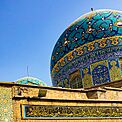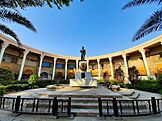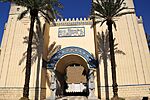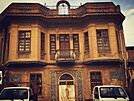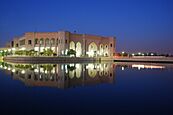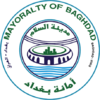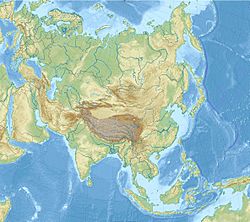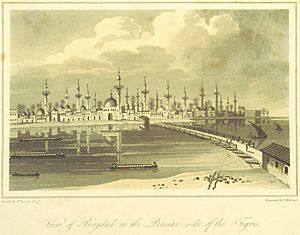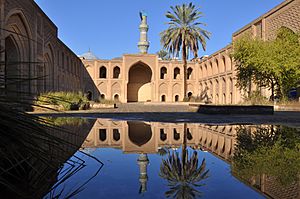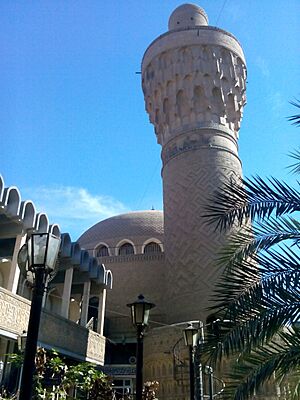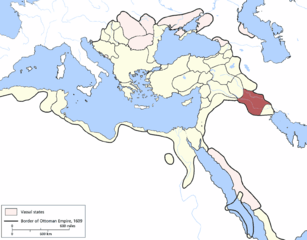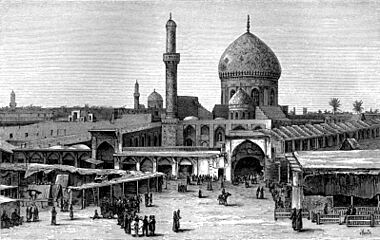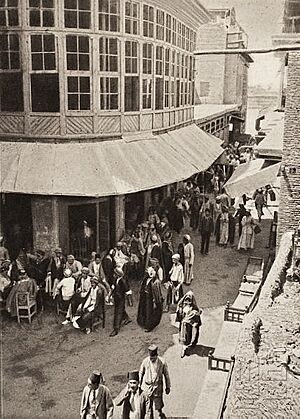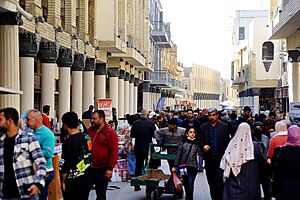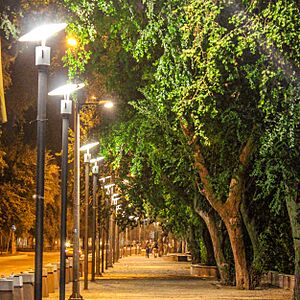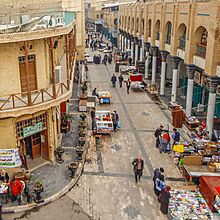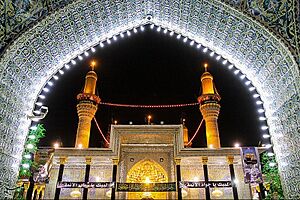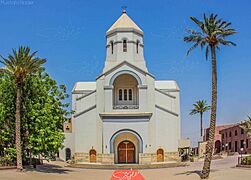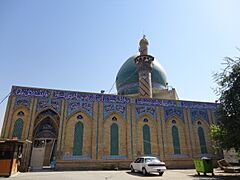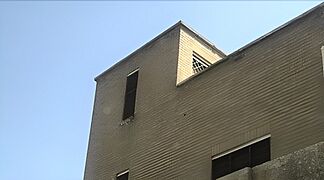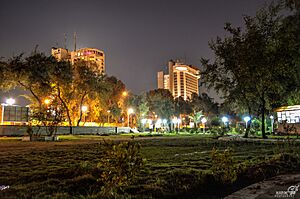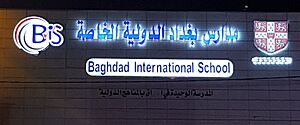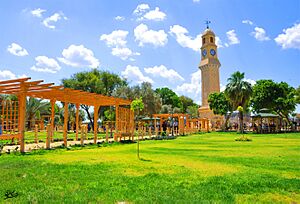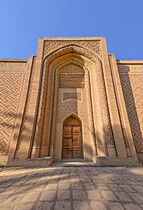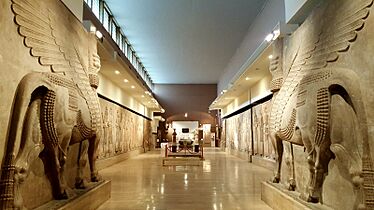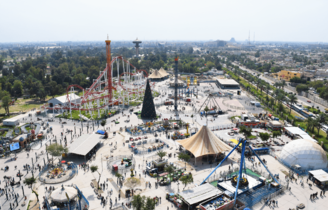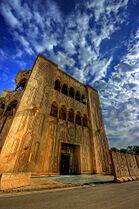Baghdad facts for kids
Quick facts for kids
Baghdad
بَغْدَاد
|
|||
|---|---|---|---|
| Mayoralty of Baghdad | |||
|
Top-bottom, L-R:
Aerial view of the Green Zone; • Tigris • Republican Palace • Al-Zawraa Park • Mutanabbi Street • Al-Kazimiyya Mosque • Al-Faw Palace |
|||
|
|||
| Nickname(s):
City of Peace (مَدِيْنَةُ السَّلَام)
|
|||
| Country | Iraq | ||
| Governorate | Baghdad | ||
| Established | 30 July 762 AD | ||
| Founded by | Caliph al-Mansur | ||
| Districts | 11 | ||
| Government | |||
| • Type | Mayor–council | ||
| • Body | Baghdad City Advisory Council | ||
| Area | |||
| • Total | 673 km2 (260 sq mi) | ||
| Elevation | 34 m (112 ft) | ||
| Population | |||
| • Estimate
(2024)
|
7,921,134 | ||
| • Rank | 1st in Iraq | ||
| • Density | 12,000/km2 (30,000/sq mi) | ||
| Demonym(s) | Baghdadi | ||
| Time zone | UTC+03:00 (Arabian Standard Time) | ||
| • Summer (DST) | (Not Observed) | ||
| Postal code |
10001 to 10090
|
||
Baghdad is the capital and largest city of Iraq. It sits right on the Tigris River. With millions of people, Baghdad is one of the biggest cities in the Arab world. It's also known as a major cultural center.
In 762 AD, Baghdad became the capital of the Abbasid Caliphate. This was a powerful Islamic empire. Soon, it grew into an important center for learning and ideas. It had famous schools like the House of Wisdom. Baghdad was a place where people from many backgrounds and religions lived together. Because of this, it was called the "Center of Learning." During the Islamic Golden Age, Baghdad was the largest city in the world. Its population reached over one million people!
However, the city was greatly damaged by the Mongol Empire in 1258. After that, Baghdad faced many challenges for centuries. This included plagues and different empires ruling it. Later, it became the capital of the British Mandate of Mesopotamia. When Iraq became an independent country in 1932, Baghdad slowly became important again.
More recently, Baghdad has faced damage from wars, especially the Iraq War that started in 2003. Many old buildings and important cultural items were lost. But terrorist attacks have become very rare since 2017. Today, Baghdad is a major city with a rich history. It is famous for its many historic mosques and museums. It's also called "City of Palaces" because of its many grand buildings.
Contents
What's in a Name?
The name Baghdad is very old, even older than Islam. People have lived in this area for thousands of years. The name's exact meaning is debated.
Many Arab writers thought the name came from an old Persian language. They often said it meant "bestowed by God." Most modern experts agree with this idea. They believe it comes from two Persian words: bagh (meaning "god") and dād (meaning "given").
When the Abbasid ruler Al-Mansur built the new capital city, he gave it an official name: "City of Peace" (Madīnat as-Salām). This name was used on coins and for official things. But most people kept calling it Baghdad. By the 11th century, "Baghdad" was the only name everyone used for this famous city.
A Look at Baghdad's History
How Baghdad Began
After the first Muslim dynasty, the Umayyads, fell, the new Abbasid rulers wanted their own capital. They chose a spot north of the old Sassanid capital, Ctesiphon. On July 30, 762 AD, Al-Mansur, the caliph (ruler), ordered the city to be built.
Al-Mansur believed Baghdad was the perfect place for the Abbasid Empire's capital. A historian named al-Tabari wrote about an old prediction. Christian monks had said that a lord named Miklas would build a great city near Baghdad. Al-Mansur was happy because he was called Miklas as a child. He loved the spot and said, "This is indeed the city that I am to found, where I am to live, and where my descendants will reign afterward."
The city grew quickly because of its great location. It controlled important trade routes along the Tigris River. It also had plenty of water, which was rare in a dry climate. Baghdad soon became so big that it was split into three main areas. Markets were kept separate from the main "Round City" to keep things peaceful. Officials called "Muhtasib" checked the markets to make sure people were honest.
Baghdad became more important than Ctesiphon, the old Sassanian capital. Ctesiphon was about 30 kilometers (19 miles) away.
The city took four years to build, from 764 to 768 AD. Al-Mansur brought engineers and builders from all over the world. Over 100,000 workers helped build the city. July was chosen to start building because astrologers believed it was a lucky time. They thought the city should be built under the sign of the lion, which meant success and growth.
The bricks used were large, about 18 inches (460 mm) on each side. Abu Hanifa, a famous scholar, helped with the bricks. He also created a canal to bring water to the building site. Marble was used for many buildings, and marble steps led down to the river.
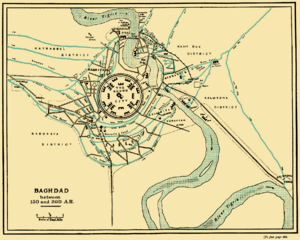
The city's main part was designed as a circle, about 2 kilometers (1.2 miles) across. This is why it was called the "Round City." It had many parks, gardens, and public baths. Unlike European cities at the time, Baghdad's streets were often cleaned. By the time of Harun al-Rashid, Baghdad had thousands of public baths. These baths helped keep people clean and healthy.
In the city center were the main mosque and guard headquarters. The circular design was inspired by old Persian city plans. This was different from Greek and Roman cities, which were usually square or rectangular.
Baghdad was a busy city day and night. It had places for entertainment like plays, concerts, and acrobats. Storytellers on street corners shared tales, some of which became part of the famous One Thousand and One Nights stories.
The city had four main walls, with gates named after important destinations: Kufa, Basra, Khurasan, and Syria. These gates pointed towards those places. The walls were very thick and tall, about 30 meters (98 feet) high. There was also an outer wall and a moat filled with water for protection.
The Golden Gate Palace, where the caliph lived, was in the center of Baghdad. It had a tall green dome. Near the palace were other grand homes. After the death of Caliph Al-Amin in 813, the palace was no longer used as the caliph's home.
A Center of Learning (8th–9th Centuries)
Soon after it was founded, Baghdad became a major center for learning and trade. The city became a top place for science, medicine, philosophy, and education. This was especially true during the Abbasid translation movement, which started under Caliph Al-Mansur and grew under Caliph Al-Ma'mun.
The House of Wisdom was one of the most famous academies. By the mid-9th century, it had the largest collection of books in the world. Important scholars in Baghdad at this time included the translator Hunayn ibn Ishaq, the mathematician al-Khwarizmi, and the philosopher Al-Kindi. People from many backgrounds, including Arabs, Persians, and Jews, contributed to this learning.
Baghdad was also a key place for Islamic religious studies. Many of the stories in One Thousand and One Nights (also called Arabian Nights) are set in Baghdad during this time. Baghdad was likely the largest city in the world until the 930s. It was even bigger and richer than Constantinople.
Baghdad had amazing libraries. Many Abbasid caliphs loved learning and collected books. While some earlier rulers had started translating Greek books, the Abbasids did it on a huge scale. Many libraries were private, but the caliphs' libraries became open to the public.
Four major libraries were built in Baghdad. The first was by Caliph Al-Ma'mun (813-833). Another was built by Sabur ibn Ardashir in 991 or 993. This library was later destroyed. The last two were part of madrasas (religious schools). The Nezamiyeh was founded by Nizam al-Mulk. The Mustansiriyah madrasa had a very rich library. It was founded by Al-Mustansir, one of the last Abbasid caliphs.
Challenges and Invasions (10th–16th Centuries)
By the 10th century, Baghdad's population was between 1.2 and 2 million. But its fast growth slowed down. This was due to problems within the Caliphate, like moving the capital and losing control of some areas. The city was also ruled by different groups, like the Iranian Buwayhids and the Seljuk Turks. The Seljuks were a group from Central Asia who became Sunni Muslims. They took control of Baghdad in 1055.
Baghdad was attacked and captured many times over the centuries. It was taken in 1394, 1534, 1623, and 1638. It also faced sieges in 812, 865, 946, 1157, 1258, 1393, and 1401.
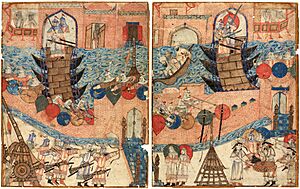
A very important event happened on February 10, 1258. Baghdad was captured by the Mongols, led by Hulegu, a grandson of Genghis Khan. Many parts of the city were destroyed by fire, fighting, or looting. The Mongols killed most of the people, including the caliph Al-Musta'sim. They also ruined the city's irrigation system. During this time, Christians and Shia Muslims were treated better than Sunnis in Baghdad. The Mongol attack ended the Abbasid Caliphate. Many historians believe this was a huge setback for Islamic civilization.
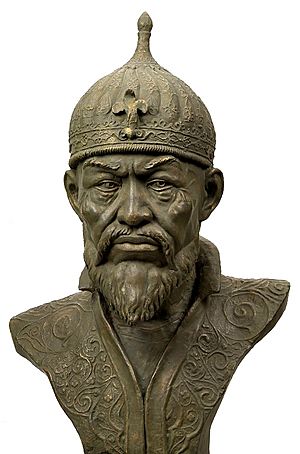
After this, Baghdad was ruled by the Ilkhanate, a part of the Mongol Empire. In 1393 and again in 1401, the conqueror Timur (also known as Tamerlane) attacked Baghdad. When his forces took the city in 1401, he spared almost no one.
Baghdad then became a smaller capital ruled by different dynasties. These included the Mongol Jalayirids, the Turkic Kara Koyunlu, the Turkic Ak Koyunlu, and the Iranian Safavids.
Ottoman and Mamluk Rule (16th–19th Centuries)
In 1534, the Ottoman Empire took over Baghdad. Under the Ottomans, Baghdad continued to decline. This was partly because of conflicts with the Iranian Safavids, who were Shia and did not like the Sunni Ottoman control. Between 1623 and 1638, Baghdad was under Iranian rule again before the Ottomans took it back.
Baghdad also suffered badly from outbreaks of plague and cholera. Sometimes, two-thirds of its people died. For a while, Baghdad had been the largest city in the Middle East. It saw some improvement in the late 1700s under Mamluk rule. But direct Ottoman rule returned in 1831.
Modern Times
Baghdad remained under Ottoman rule until 1917. Then, the British captured it during World War I. In 1920, Baghdad became the capital of the British Mandate of Mesopotamia. This meant it was governed by Britain. When Iraq became independent in 1932, Baghdad became the capital of the Kingdom of Iraq.
During this time, Baghdad had a large Jewish community, possibly over 100,000 people. In 1941, there was a coup in Baghdad. A pro-German government took over briefly. After the British returned, Jewish residents were attacked in an event called the Farhud. Many Jews were killed or injured, and their homes were looted.
Baghdad's population grew a lot, from about 145,000 in 1900 to 580,000 in 1950.
In 1958, the Iraqi Army overthrew the monarchy. King Faisal II and his family were killed. In the 1970s, Baghdad became rich because of high oil prices. New roads, water systems, and other modern facilities were built. Saddam International Airport opened in 1982.
However, the Iran–Iraq War in the 1980s was hard on the city. Money went to the army, and many people died. Iran launched missile attacks on Baghdad. Between 1990 and 1991, the city was bombed during the Gulf War. After the war, there was unrest. But the government also worked to make the city beautiful. Saddam built many palaces and monuments in Baghdad.
In 2003, the invasion of Iraq by the United States caused huge damage. Baghdad's transport, power, and water systems were badly hit. The airport was renamed Baghdad International Airport. After the fall of Baghdad, Saddam's statue was pulled down in Firdos Square. This marked the end of his rule.
During the Iraq War (2003-2011), many valuable items were stolen from the National Museum of Iraq. The city's historic Jewish Quarter declined. Many Christians and Mandaeans left the city. Thousands of old books in the National Library were destroyed.
Since the war, Baghdad has been working to rebuild. In 2015, UNESCO chose Baghdad as the first Arab city for literary creativity.
Baghdad's Location and Weather
Geography
Baghdad is on a large, flat plain. The Tigris River cuts through the city. The eastern half is called "Risafa" and the western half is "Karkh". The land is very flat because of past floods from the river.
Climate
Baghdad has a hot desert climate. This means it has very hot, long, dry summers. Winters are mild to cool and a bit wet.
In summer (June to August), the average high temperature is around 44°C (111°F). It's very sunny. Rain almost never falls in summer. Even at night, temperatures rarely drop below 24°C (75°F). The highest temperature ever recorded in Baghdad was 51.8°C (125.2°F) on July 28, 2020. The air is usually dry in summer. Dust storms from the deserts are common.
Winter temperatures are typical for a hot desert climate. From December to February, highs are around 16 to 19°C (61 to 66°F). Temperatures below freezing happen a couple of times a year.
Baghdad gets about 150 mm (5.9 inches) of rain each year. Most of this rain falls from November to March. Light snow fell in Baghdad in January 2008 for the first time in 100 years. Snow was seen again in February 2020.
How Baghdad is Governed
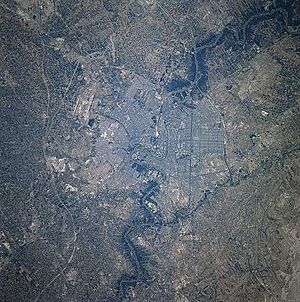
Baghdad is divided into districts, which are then split into smaller areas. The city has 9 municipalities that handle local issues. A mayor oversees these municipalities. The Baghdad City Advisory Council helps make decisions for the whole city.
After 2003, a new system was set up. People in neighborhoods elected councils. These neighborhood councils then chose representatives for 9 district councils. Finally, the district councils elected members for the 37-member Baghdad City Council. This system connects the people to the government.
The nine main districts are:
- Adhamiyah
- Karkh (Green Zone)
- Karrada
- Kadhimiya
- Mansour
- Sadr City (Thawra)
- Al Rashid
- Rusafa
- New Baghdad (Tisaa Nissan) (9 April)
These districts are further divided into 89 smaller neighborhoods. Some of these include:
- Al-Ghazaliya
- Al-A'amiriya
- Dora
- Karrada
- Al-Jadriya
- Al-Hebnaa
- Zayouna
- Al-Saydiya
- Al-Sa'adoon
- Al-Shu'ala
- Al-Mahmudiyah
- Bab Al-Moatham
- Al-Baya'
- Al-Za'franiya
- Hayy Ur
- Sha'ab
- Hayy Al-Jami'a
- Al-Adel
- Al Khadhraa
- Hayy Al-Jihad
- Hayy Al-A'amel
- Hayy Aoor
- Al-Hurriya
- Haydar-Khana
- Hayy Al-Shurtta
- Yarmouk
- Jesr Diyala
- Abu Disher
- Al-Maidan
- Raghiba Khatoun
- Arab Jibor
- Al-Fathel
- Al-Ubedy
- Al-Washash
- Al-Wazireya
- Bataween
Famous Streets in Baghdad
Baghdad has many important and well-known streets:
- Haifa Street
- Hilla Road – Leads into Baghdad from the north.
- Caliphs Street – Has many old mosques and churches.
- Al-Sa'doun Street – Stretches from Liberation Square.
- Abu Nuwas Street – Runs along the Tigris River.
- Damascus Street – Connects to the Baghdad Airport Road.
- Mutanabbi Street – Famous for its many bookshops. It's named after a 10th-century Iraqi poet. This street is known as the heart of Baghdad's literary community.
- Rabia Street
- 14th July Street (Mosul Road)
- Muthana al-Shaibani Street
- Bor Saeed (Port Said) Street
- Thawra Street
- Al-Qanat Street – Runs north-south through Baghdad.
- Al-Khat al-Sare'a – Mohammed al-Qasim (high speed lane) – Also runs north-south.
- Industry Street – Near the University of Technology, a center for computer trade.
- Al Nidhal Street
- Al-Rasheed Street – In the city center.
- Al-Jumhuriya Street – Also in the city center.
- Falastin Street
- Tariq al-Muaskar – (Al-Rasheed Camp Road)
- Akhrot street
- Baghdad Airport Road
People of Baghdad
Population and Groups
In 2015, Baghdad's population was estimated at 7.22 million. The larger metropolitan area has about 10.5 million people. It is the second-largest city in the Arab world, after Cairo.
Most people in Baghdad are Iraqi Arabs. There are also smaller groups like Feyli Kurds, Turkmen, Assyrians, and Armenians. The city also used to have a large Jewish community.
The "Assyrian Quarter" of Dora had about 150,000 Assyrians in 2003. But many have left due to violence and threats. By the end of 2014, only about 1,500 Assyrians remained in Dora.
Religions in Baghdad
Historically, Baghdad had mostly Sunni Muslims. But by the early 21st century, about 52% of the city's people were Iraqi Shi'ites. After the civil war between Sunni and Shia groups, the number of Sunnis in some neighborhoods decreased.
Most citizens are Muslims. There are also smaller groups of Christians, Yezidis, Jews, and Mandeans. The city has many mosques, churches, synagogues, and Mandaean temples.
Masjid Al-Kadhimain is a very important shrine in the Kādhimayn area. It holds the tombs of two important Twelver Shi'ite Imams. Many Shi'ites travel there for pilgrimage.
Before the 2003 Iraq War, Baghdad had over 300,000 Christians. They lived mostly in areas like Karrada and Dora. The Christian community includes different groups like the Chaldean Catholic Church and the Syriac Catholic Church. Baghdad is also home to the largest Armenian Apostolic and Protestant communities in Iraq.
In the early 1950s, Jews made up 25% of Baghdad's population. Most lived near Al-Sa'doun Street and Shorja. Baghdad had 60 synagogues. But due to increasing difficulties, most Jews left Iraq in 1951. Today, only about 100 Jews live in Baghdad, mainly in Bataween. The Meir Taweig Synagogue is the only working synagogue.
The house of Baháʼu'lláh, the founder of the Baháʼí Faith, was in Baghdad. It was a holy place for Baha'is. Sadly, it was destroyed in 2013. Most Iraqi Mandaeans live in Baghdad. The city also used to be visited by Sikh pilgrims from India. The Baba Nanak Shrine, a Sikh holy site, was destroyed during the Iraq War.
Baghdad's Economy
Baghdad is the main financial and business center of Iraq. It makes up a large part of Iraq's economy. During the Abbasid era, Baghdad was one of the world's top economic centers.
As the capital, Baghdad is home to government offices and state-owned businesses. Many Iraqi banks and international companies have their main offices here. Since the war, Baghdad has hosted many business meetings and trade shows.
The city was once a popular tourist spot with many cultural attractions. Tourism decreased after the Iran–Iraq War and the 2003 invasion. But in recent years, Baghdad has started to attract tourists again.
Baghdad has many museums, like the Iraq Museum and the Baghdadi Museum. It is famous for Mutanabbi Street, known for its bookselling. This street is seen as the heart of Baghdad's literary community. The annual International Book Fair in Baghdad is also well-known.
Many Iraqi companies, like BaghTel and Fly Baghdad, have their headquarters in Baghdad. International companies like General Electric and Shell also have offices here. Most of these offices are on Al-Rashid Street.
Baghdad has natural resources like aluminum and nickel. An oilfield is located in eastern Baghdad. The city also has a large oil refinery called "Dora Refinery." Baghdad produces many goods, including food, clothes, furniture, chemicals, and electrical equipment.
Efforts are being made to rebuild Baghdad's damaged infrastructure. There are also plans for new private developments. In 2008, a plan was proposed to rebuild a tourist island on the Tigris River. It would include a luxury hotel, a golf course, and a country club. There are also plans for new skyscrapers along the Tigris.
In 2009, a plan to rebuild the heart of Baghdad was proposed, but it didn't happen. The Baghdad Eye Ferris wheel was installed in Al-Zawraa Park in 2011. In 2010, a new large project called Baghdad Gate was announced. Also in 2010, the famous architect Zaha Hadid was chosen to design a new headquarters for the Central Bank in Baghdad. Construction started in 2019. Baghdad is also seeing new modern businesses and startup centers.
Getting Around Baghdad
Baghdad doesn't have much public transportation. Taxis are the main way people get around. Roads in Baghdad can be very crowded.
Iraqi Airways, Iraq's national airline, operates from Baghdad International Airport. The airport opened in 1982. It was renamed in 2003 after the invasion.
Future Baghdad Metro
The idea for a Baghdad Metro (subway system) was first suggested in the 1970s. But wars and problems stopped it from being built. After the Iraq War, authorities wanted to start the project again, but it was delayed.
In 2019, it was reported that Korean and French companies would start building it. However, this didn't happen.
As of early 2024, the current plan is for a modern, driverless electric train system. It would have underground and elevated tracks. The proposed Baghdad Metro would have seven main lines, over 148 kilometers (92 miles) long, with 64 stations. It would also have workshops, control centers, and power stations. The metro would have cameras and internet access. Special areas would be for women and children, and seats for people with special needs.
The metro stations would connect to buses and taxis. There would also be parking for commuters. The trains would travel at speeds of 80–140 km/hour (50–87 mph). It's estimated that 3.25 million riders would use it every day.
In July 2024, it was announced that a group of French, Spanish, and Turkish companies, along with Deutsche Bank, won a $17.5 billion contract to build Baghdad's metro. The project is expected to be finished by May 2029.
Learning in Baghdad
The House of Wisdom was a very important center for learning in Baghdad. The Mustansiriya Madrasa was founded in 1227. Its name was changed to al-Mustansiriya University in 1963. The University of Baghdad is the largest university in Iraq.
Some other universities in Baghdad are:
- University of Baghdad
- Mustansiriya University
- Iraqi University
- Nahrain University
- Albayan University
- University of Technology, Iraq
- American University of Iraq – Baghdad
- Al-Turath University College
- Dijlah University College
Baghdad's Culture
Baghdad has always been very important in Arab culture. Many famous Arab writers, musicians, and artists come from or are linked to Baghdad. Famous singers like Umm Kulthum and Fairuz have performed in the city.
The type of Arabic spoken in Baghdad today is a bit different from other big cities in Iraq. This might be because many people from rural areas moved to the city after it was attacked many times in the past. In December 2015, Baghdad joined the UNESCO Creative Cities Network as a "City of Literature."
Some important cultural places in the city include the National Theater. It was looted in 2003, but people are working to restore it. Live theater became popular in the 1990s when it was hard to get foreign films. Many movie theaters became stages for plays.
Schools like The Music and Ballet School of Baghdad teach cultural arts. The Iraqi National Symphony Orchestra plays classical European music and Iraqi music. Baghdad also has many museums with ancient artifacts. Sadly, many of these were stolen during the chaos after the 2003 invasion.
Places to See in Baghdad
- The National Museum of Iraq has a huge collection of ancient artifacts. Many were looted in 2003.
- Mutanabbi Street is near the old part of Baghdad. It's a historic street full of bookstores and outdoor book stalls. It's named after a famous Iraqi poet.
- Baghdad Zoo used to be the largest zoo in the Middle East. After the 2003 invasion, only 35 of its 650 animals survived. Some were stolen for food, and others starved.
- Grand Festivities Square is a big public square where celebrations are held. It has three important monuments: Al-Shaheed Monument, the Victory Arch, and the Unknown Soldier's Monument.
- Al-Shaheed Monument, also called the Martyr's Memorial, honors Iraqi soldiers who died in wars. It was opened in 1983.
- Qushla or Qishla is a historic public square by the Tigris River. It's where many of Baghdad's historical and cultural sites are, like Mutanabbi Street and old mosques. It used to be a military barracks. Today, people go there to relax and read poetry. It has a famous clock tower. This area is being considered for a UNESCO World Heritage Site listing.
- A'dhamiyyah is an area with the Abu Hanifa Mosque. This mosque is linked to the important Sunni Imam Abu Hanifa.
- Firdos Square is a public space in Baghdad. It's where the Palestine Hotel and Sheraton Ishtar are located. This square was famous for the statue of Saddam Hussein that was pulled down in 2003.
- The Jewish Quarter of Baghdad is around the Bataween, At-Turat, and Shorja areas. It has historic homes where Jewish families once lived. The Meir Taweig Synagogue is here and is the only working synagogue.
- Al-Rasheed Street is a very important landmark in Baghdad. It was a center for art, ideas, and culture. It had theaters and nightclubs. It also has famous cafes and beautiful architecture.
Sports in Baghdad
Baghdad is home to some of the most successful football (soccer) teams in Iraq. The biggest ones are Al-Shorta (Police), Al-Quwa Al-Jawiya (Air Force), Al-Zawraa, and Al-Talaba (Students).
The largest stadium in Baghdad is Al-Shaab Stadium, opened in 1966. New football stadiums are being built in the capital. Baghdad also has a long history of horse racing, known as 'Races'.
| Club | Founded | League |
|---|---|---|
| Al-Quwa Al-Jawiya SC | 1931 | Iraq Stars League |
| Al-Shorta SC | 1932 | Iraq Stars League |
| Al-Zawraa SC | 1969 | Iraq Stars League |
| Al-Talaba SC | 1969 | Iraq Stars League |
Sister Cities
Baghdad has friendly ties with these cities:
See also
 In Spanish: Bagdad para niños
In Spanish: Bagdad para niños



